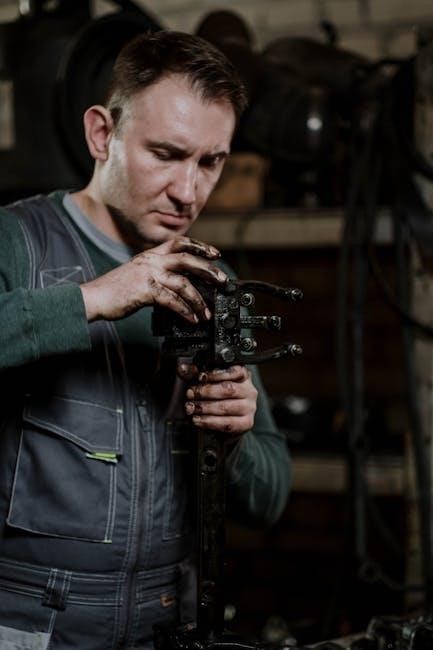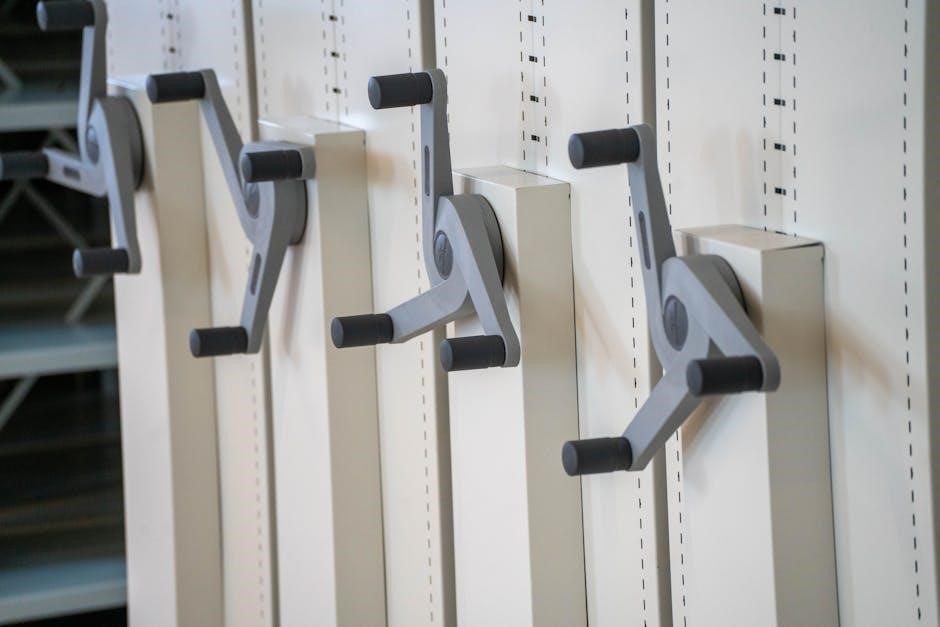HWH leveling systems are hydraulic solutions for RVs and motorhomes, providing manual and automatic options for stability. Proper leveling ensures safety, prevents damage, and enhances comfort for enjoyable RV experiences.

Common Hydraulic Issues
Hydraulic leaks from worn seals or damaged hoses are frequent problems. Low fluid levels or visible oil spots indicate leaks, requiring immediate attention to prevent system malfunctions and damage.
2.1 Identifying Leaks
Identifying leaks in the HWH leveling system involves a thorough inspection of hydraulic lines and connections. Start by visually examining all hoses, fittings, and seals for signs of wear or damage. Look for oil droplets, damp spots, or discoloration, which are common indicators of leaks. Use a flashlight to inspect hard-to-reach areas, such as underneath the RV or behind hydraulic components. Additionally, check the hydraulic fluid reservoir for any noticeable drops in fluid levels, as this can signal a leak. Operating the leveling system while observing hydraulic lines can help pinpoint where leaks occur during operation. Regular inspections are crucial for early detection and prevention of potential system damage.
2.2 Repairing Leaks
Repairing leaks in the HWH leveling system requires careful attention to detail and the right tools. Begin by turning off the system and cleaning the affected area with a degreaser to identify the exact source of the leak. For minor leaks in fittings, gently tighten the connections without over-tightening, as this could cause further damage. If tightening doesn’t resolve the issue, replace the fitting entirely. For leaks in hydraulic lines, use a hydraulic repair kit, which typically includes patches and sealants. Follow the kit’s instructions to apply the repair effectively. In cases of extensive damage, replace the entire hydraulic line to ensure system integrity. After completing repairs, refill the hydraulic fluid and test the system by operating the leveling jacks to confirm the leak has been fixed. Regular maintenance and inspections can prevent future leaks.

Sensor Troubleshooting
Sensors are critical for accurate leveling. Inaccurate readings, unresponsive panels, or error codes indicate sensor issues. Clean dirty sensors and check connections to restore proper system performance.
3.1 Recognizing Failures
Sensor failures in HWH leveling systems often manifest through inaccurate readings, unresponsive control panels, or error codes. Common symptoms include the system’s inability to level properly, erratic movements, or unexpected shutdowns. Faulty sensors may also cause the control panel to display misleading information, such as incorrect height or tilt measurements. Additionally, sensors that are dirty or corroded can disrupt communication between components, leading to poor system performance. Identifying these signs early is crucial to prevent further complications. Regular inspection and testing of sensors can help detect issues before they escalate, ensuring the system operates efficiently and maintains the stability of your RV.
3.2 Replacing Sensors
Replacing sensors in an HWH leveling system requires careful steps to ensure proper functionality. Begin by powering off the system and consulting the manual to locate the faulty sensor. Disconnect the sensor’s electrical connections gently to avoid damage. Remove the old sensor and install the new one in the same position, ensuring it is securely fastened. Reconnect the electrical connections and test the system to confirm accurate readings. Regular sensor replacement maintains system accuracy and prevents leveling errors. Always use sensors compatible with your HWH model for optimal performance. If unsure, refer to the troubleshooting manual or seek professional assistance to avoid further complications.
Electrical System Problems
Electrical issues in HWH leveling systems often stem from blown fuses or damaged wiring. Regularly inspect connections and replace faulty components to ensure smooth system operation and safety.
4.1 Blown Fuses
A blown fuse in an HWH leveling system often disrupts operation, requiring immediate attention. To address this, locate the fuse box, typically found near the control panel or battery. Inspect each fuse for signs of damage, such as discoloration or a broken filament. Replace blown fuses with ones of the same amperage rating to maintain system integrity. Always turn off the system before performing repairs to avoid further electrical issues. If frequent blown fuses occur, it may indicate an underlying electrical problem that requires professional inspection to prevent recurring malfunctions and ensure the system functions safely and efficiently.
4.2 Wiring Issues
Wiring issues are a common cause of electrical problems in HWH leveling systems. To identify these issues, inspect all wiring connections for signs of wear, corrosion, or damage. Ensure that all wires are securely connected to their respective terminals. If a wire is loose or damaged, repair or replace it promptly. Use a multimeter to check for continuity and voltage drops, which can help pinpoint faults. Regularly cleaning connections and applying dielectric grease can prevent corrosion. If wiring issues persist after these checks, consult a professional technician to avoid further complications and ensure the system operates safely and efficiently. Proper wiring maintenance is essential for the longevity and reliability of your HWH leveling system.

Calibration Guide
Calibration ensures optimal HWH system performance. Gather necessary tools and follow the step-by-step process outlined in the manual for accurate adjustments and reliable leveling.
5.1 Tools Required
Calibrating an HWH leveling system requires specific tools to ensure accuracy. Essential items include a multimeter for electrical checks, a torque wrench for secure connections, and hydraulic fluid for refilling. A pressure gauge is necessary to monitor system pressure, while adjustable wrenches and pliers help with fittings. Cleaning supplies like degreasers and rags are needed to prepare surfaces. For manual systems, a leveling tool or spirit level ensures precise adjustments; Additionally, diagnostic tools like jumper wires and a service manual are crucial for troubleshooting. Always use high-quality tools to avoid damaging components. Refer to the HWH manual for a detailed list of required tools and specifications to ensure a successful calibration process.
5.2 Step-by-Step Process
Calibrating an HWH leveling system involves a systematic approach. Begin by ensuring the RV is on a level surface and all jacks are fully retracted. Turn on the system and enter calibration mode via the control panel. Allow the sensors to zero out by pressing and holding the calibration button. Next, extend the jacks slightly and use the control panel to adjust each jack’s height until the RV is level. Verify the system’s accuracy with a spirit level. Once calibrated, save the settings. If issues arise, consult the manual or reset the system. Regular recalibration ensures optimal performance. Always follow the manufacturer’s instructions for precise calibration.
Maintenance Tips
Regularly inspect hydraulic lines, sensors, and jacks for damage. Lubricate moving parts and clean debris to ensure smooth operation. Schedule routine checks to prevent system malfunctions and extend lifespan.
6.1 Inspection Schedule
Maintaining an HWH leveling system requires a structured inspection schedule. Begin with daily pre-operation checks to ensure all components are functioning correctly. Weekly, inspect hydraulic lines, sensors, and jacks for any visible damage or leaks. Monthly, clean the system to remove dirt and debris, which can interfere with proper operation. Every three months, lubricate moving parts to prevent wear and tear. Annually, perform a comprehensive check of the entire system, including fluid levels and electrical connections, to identify potential issues early. Adhering to this schedule ensures optimal performance, prevents unexpected malfunctions, and extends the lifespan of your HWH leveling system.
6;2 Lubrication Best Practices
Regular lubrication is essential for maintaining the efficiency and longevity of your HWH leveling system. Start by identifying all moving parts, such as hydraulic cylinders and pivot points, and apply a high-quality, silicone-based lubricant. Avoid using oil-based products, as they may attract dust and dirt. Before lubricating, clean the surfaces thoroughly to ensure the product adheres properly. Apply the lubricant evenly, following the manufacturer’s instructions. Repeat this process every 3 to 6 months or as needed, depending on usage. Additionally, lubricate after washing or exposure to harsh weather conditions. Proper lubrication prevents corrosion, reduces friction, and ensures smooth operation of the system. Always refer to your HWH manual for specific recommendations, as improper lubrication can damage components. Regular maintenance keeps your leveling system functioning optimally and extends its lifespan.

Professional Help
Professional help is crucial for complex issues beyond basic troubleshooting. Certified technicians can address advanced problems, ensuring safety and system longevity. Seek experts for intricate repairs and diagnostics.
7.1 Knowing When to Seek
Determining when to seek professional help for your HWH leveling system is crucial. If issues like hydraulic leaks, sensor malfunctions, or electrical faults persist despite troubleshooting, it’s time to consult an expert. Complex problems such as software glitches or system-wide hydraulic failures often require specialized tools and knowledge. Ignoring these can lead to further damage or safety hazards. Additionally, if you’re unsure about the cause of a problem or lack the necessary skills to fix it, reaching out to a certified technician is advisable. They can diagnose and resolve issues efficiently, ensuring your system operates safely and effectively.
7.2 Finding Certified Technicians
Locating a certified technician for your HWH leveling system is essential for reliable repairs. Start by visiting the HWH Corporation website, which provides a list of authorized service centers. These centers employ technicians trained specifically on HWH systems, ensuring expertise in handling complex issues. Additionally, online review platforms like Google or Yelp can help identify reputable RV repair shops in your area. Look for technicians with high ratings and positive feedback from other RV owners. Contacting local RV dealerships or communities can also yield recommendations. Always verify certifications and ask about experience with HWH systems before scheduling service to ensure your repairs are done correctly and efficiently.
Additional Tips
Preventative maintenance and regular inspections are crucial for optimal performance. Implement safety precautions like using jack stands and avoiding overload to ensure reliable operation and longevity of your HWH system.
8.1 Prevention Measures
Regularly inspect hydraulic lines and connections for signs of wear or leaks. Lubricate moving parts to prevent friction and corrosion. Keep the system clean to avoid debris buildup. Ensure all components are secure before operation. Monitor hydraulic fluid levels and top up as needed. Avoid overloading the system, as this can strain the jacks and sensors. Schedule annual professional inspections to catch potential issues early. By implementing these prevention measures, you can significantly reduce the risk of system failures and extend the lifespan of your HWH leveling system. Consistent maintenance ensures reliability and safety, minimizing downtime during trips.
8.2 Safety Precautions
Always turn off the HWH leveling system before performing any maintenance or repairs. Ensure the RV is on level ground and apply the parking brake to prevent movement. Use jack stands for additional support when working under the vehicle. Wear protective gear, such as gloves and safety goggles, to avoid injury from potential hydraulic fluid leaks or moving parts. Never operate the system if hydraulic lines are damaged or leaking, as this can lead to sudden system failure. Keep the area clear of flammable materials, as hydraulic fluid can be hazardous. Avoid overloading the system beyond its recommended capacity, as this can cause instability. Follow all manufacturer guidelines and avoid bypassing safety features. If unsure about any procedure, consult a professional technician to ensure safe and proper handling of the system.
